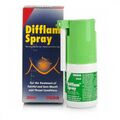Benzydamine
| Benzydamine | |||||||||||||||||||||||||||||||
|---|---|---|---|---|---|---|---|---|---|---|---|---|---|---|---|---|---|---|---|---|---|---|---|---|---|---|---|---|---|---|---|
 |
|||||||||||||||||||||||||||||||
| Chemical Nomenclature | |||||||||||||||||||||||||||||||
| Common names | Benzydamine, Tantum Verde | ||||||||||||||||||||||||||||||
| Substitutive name | Benzydamine | ||||||||||||||||||||||||||||||
| Systematic name | 3-(1-Benzyl-1H-indazol-3-yloxy)-N,N-dimethylpropan-1-amine | ||||||||||||||||||||||||||||||
| Class Membership | |||||||||||||||||||||||||||||||
| Psychoactive class | Deliriant / Stimulant | ||||||||||||||||||||||||||||||
| Chemical class | Indazole | ||||||||||||||||||||||||||||||
| Routes of Administration | |||||||||||||||||||||||||||||||
|
|||||||||||||||||||||||||||||||
| Interactions | |||||||||||||||||||||||||||||||
| Summary sheet: Benzydamine |
Benzydamine (also known as Tantum Verde) is a topical anaesthetic of the benzyl-indazole chemical class. It is commonly found in small doses in over-the-counter products used to treat sore throats. In Germany and Poland, it is sold as a vaginal douching agent under the brand name Tantum Rosa. This product is also freely available across the world through the use of online stores such as eBay.
Alternatively, benzydamine can be used as a powerful psychoactive hallucinogen for recreational or entheogenic purposes. In high doses, it acts as a unique deliriant and CNS stimulant.[1] Such use, particularly among teenagers, has been reported in Poland,[2] Brazil[3][4] and Romania.
Chemistry
Benzydamine, or 3-(1-benzylindazol-3-yl)oxy-N,N-dimethylpropan-1-amine, is a synthetic benzyl-indazole molecule. Benzydamine contains a benzene and pyrazole ring fused to form a bicyclic indazole group. A benzyl substituent C6H5CH2- is bound to R1 of the indazole ring. This indazole ring is also substituted at R3 with an ether chain consisting of the oxygen group bonded to a propyl amine chain. The terminal amine RN of this structure is substituted with two methyl groups (dimethyl). Benzydamine is produced as a hydrochloride salt.
Pharmacology
Benzydamine is a locally acting nonsteroidal anti-inflammatory drug with local anaesthetic and analgesic properties. Unlike other NSAIDs, it does not inhibit cyclooxygenase or lipooxygenase and is not ulcerogenic.
In terms of the pharmacology behind its hallucinogenic effects, this aspect of benzydamine remains unstudied and is subject to much speculation.
Subjective effects
 |
This subjective effects section is a stub. As such, it is still in progress and may contain incomplete or wrong information. You can help by expanding or correcting it. |
Physical effects
- Stimulation - Insomnia and residual stimulation lasting up to 72 hours after the initial experience may occur on this substance.
- Abnormal heartbeat
- Tactile suppression
- Increased heart rate
Visual effects
- External hallucinations (autonomous entities; settings, sceneries, and landscapes; alterations in perspective and scenarios and plots)
- Visual acuity suppression
- Drifting
- Visual haze
Cognitive effects
Auditory effects
Toxicity and harm potential
The vaginal douching agents such as Tantum Rosa and other products consistently contain large amounts of salt which, if consumed, can cause serious kidney damage.
Extraction
Benzydamine is usually extracted from Tantum Rosa douching agents which are available online. In order to consume the substance safely, one must first remove the dangerous levels of salt contained within the sachet. This can be done by dissolving the substance in a small amount of water (25ml/sachet) and filtering through a paper filter. The salt will dissolve in water to create a saturated solution. The powder left on the filter can then be dried and consumed by either eating or dissolving it in liquid and drinking. It is not advised to drink the water used to dissolve the salt.[5]
Legal issues
Benzydamine is legal and available in over-the-counter preparations in most parts of the world.
-
Difflam spray
-
Tantum Rosa
-
Difflam mouth gel
See also
External links
- Benzydamine (Wikipedia)
- Benzydamine (Taimapedia)
- Benzydamine (Bluelight)
- Benzydamine (DrugForum)
- Benzydamine (Reddit)
References
- ↑ Recreational abuse with benzydamine hydrochloride (tantum rosa) | http://www.ncbi.nlm.nih.gov/pubmed/17364645
- ↑ Recreational abuse with benzydamine hydrochloride (tantum rosa) | http://www.ncbi.nlm.nih.gov/pubmed/17364645
- ↑ Recreational use of benzydamine as a hallucinogen among street youth in Brazil | http://www.ncbi.nlm.nih.gov/pubmed/19784487
- ↑ Use abusive of benzydamine in Brazil: an overview in pharmacovigilance | http://www.ncbi.nlm.nih.gov/pubmed/19784487
- ↑ http://hyperreal.info/node/2265 (Polish)


